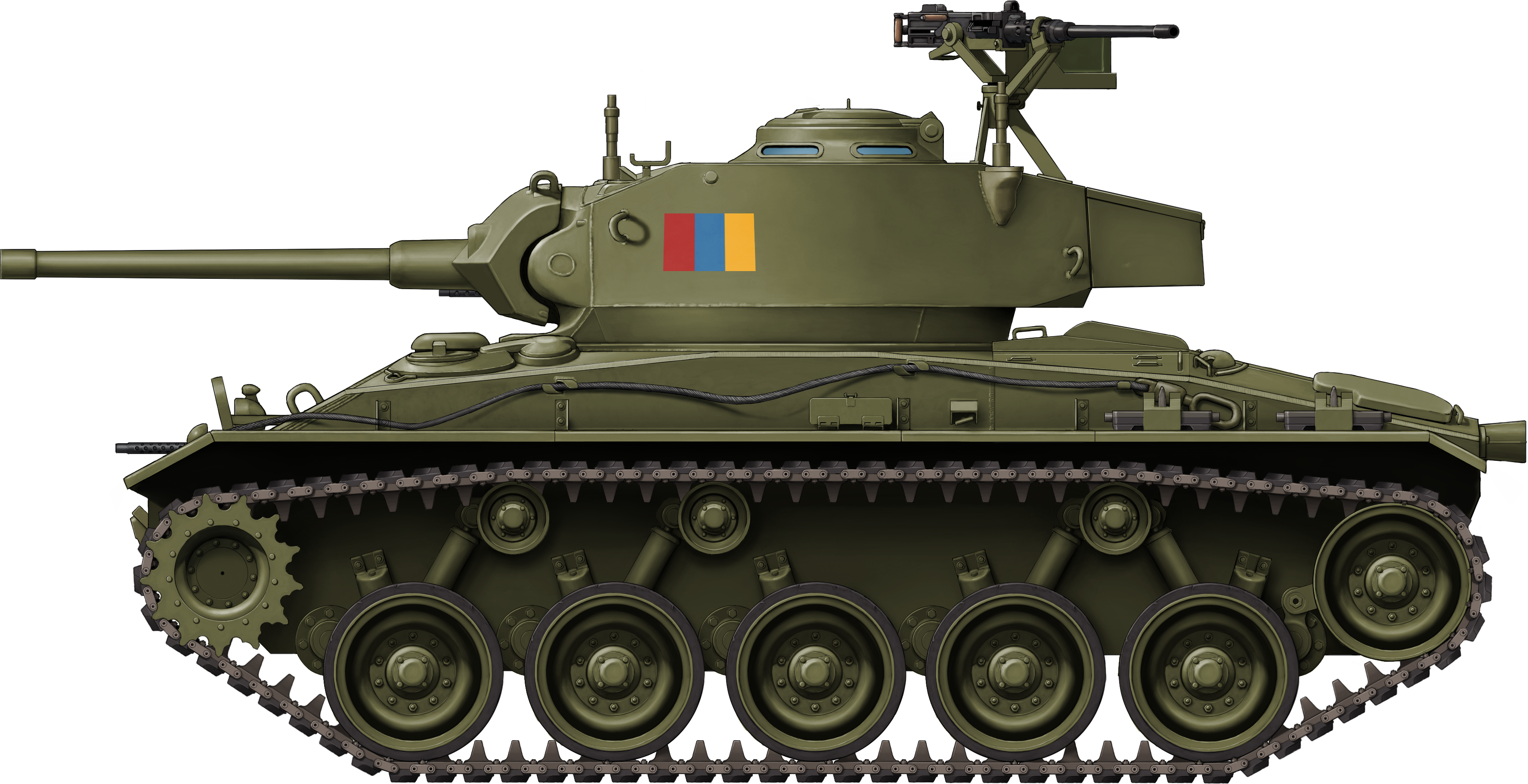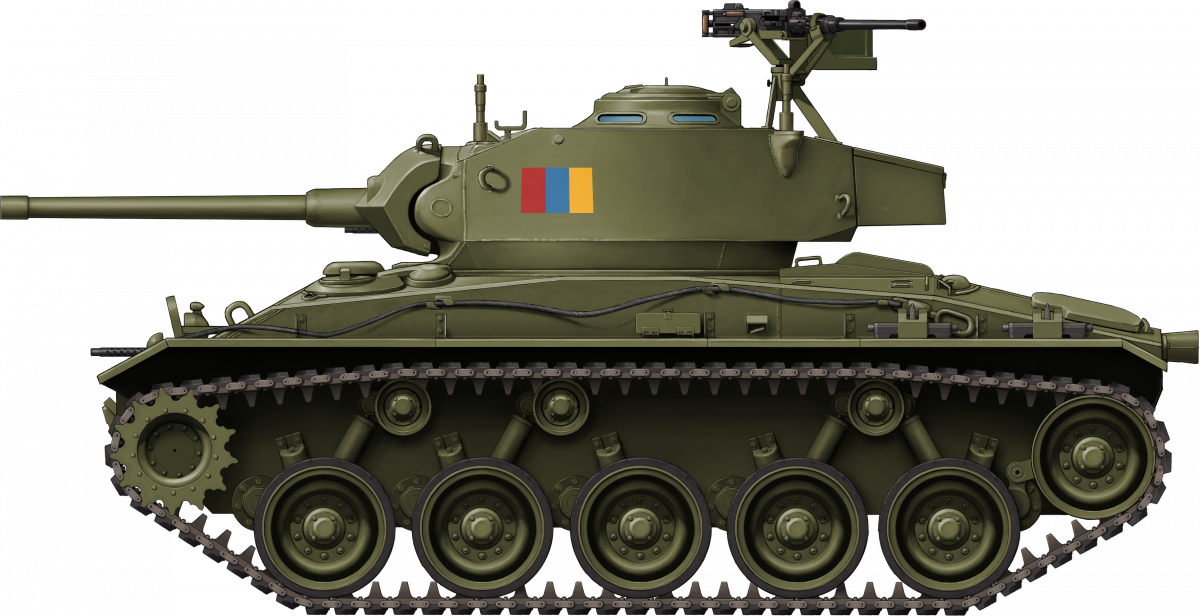 Italian Republic (1950-1970s)
Italian Republic (1950-1970s)
Light Tank – 518 Operated
The Carro Armato Leggero M24 (English: M24 Light Tank) was the Italian designation for the M24 Chaffee tanks that were delivered to the Repubblica Italiana (English: Italian Republic) after 1950. The tank had entered service with the US Army in 1944 with the aim of replacing the older M5A1 Stuart and was designed for reconnaissance tasks. Its role remained the same in the Esercito Italiano (English: Italian Army), which used it until the 1970s, eventually allocating it solely for training purposes in the latter section of that period.


Source: Storia Militare Dossier N. 24
History of the Vehicle
During the campaign in North Africa against the Italians and Germans, the US Army realized that the 37 mm cannon of the Stuart tanks was outdated. Therefore, they initiated a project for a light tank, named T24, on 29th April 1943, which was entrusted to the General Motors Corporation.
The new design featured a completely new vehicle with five-wheel torsion bar suspension and three track supports, powered by a Cadillac engine of the same model used on the M5 Stuart.
The main armament was developed from the 75 mm aircraft cannon T13E1, used on the B25 Mitchell bombers, called the M6 gun. It had less recoil than the M3 cannon used on the M4 Sherman but shared the same ballistics.
The first test of the new tank was conducted at Aberdeen on 15th October 1943. Mass production began in April 1944, and the new vehicle was named ‘Chaffee’ after General Adna R. Chaffee Jr., one of the fathers of the US armored units.

Source: m24chaffee.com
From April 1944 to July 1945, 4,731 M24s were produced, with 3,592 built by Cadillac and 1,130 by Massey-Harris. The new tank saw its first action in France in December 1944, with two participating in combat in the Ardennes with the 740th Tank Battalion. Another 18 were assigned to the 744th Tank Battalion on December 24 and fought during the battles near the River Rhine.
There were immediate complaints about the vehicle because its armor did not provide great defense against German anti-tank weapons, and the 75 mm cannon was rather ineffective against enemy vehicles. As a result, the 744th Tank Battalion was re-equipped with medium tanks M4A3 (76 mm).
However, it was highly appreciated as a reconnaissance tank, considered vastly superior to the Stuarts or the M8 Greyhound armored cars. By the end of the war in Europe in May 1945, the M24s, totaling 1,163, accounted for 24% of all American light tanks deployed on the Old Continent.

Source: US Army
The tank was also distributed in small numbers to Britain, France, and the Soviet Union, and after the war, it saw action in the Korean War, proving to be a poor match against North Korean T-34/85s.

Source: US Army
Nevertheless, it was exported to many NATO countries, as well as to Asian and African nations, and phased out of service in the 1970s and 1980s.
Italy and its Armed Forces after the Second World War
The Kingdom of Italy, later the Italian Republic from 2nd June 1946, emerged from the Second World War as a defeated and devastated nation, stripped of all its colonies and some territories (Istria, the city of Rijeka, and certain areas along the border with France) following the Paris Peace Treaty of 1947.
The Italian army was greatly reduced and temporarily renamed Esercito di Transizione (English: Transitional Army). In 1947, the Esercito Italiano could amass a maximum of 140,000 to 150,000 personnel to maintain public order in a divided country. Italy was plagued by numerous riots, and in Sicily, the issue of brigandry persisted. This was preceded until 1946 by the actions of the Esercito Volontario per l’Indipendenza della Sicilia (English: Volunteer Army for the Independence of Sicily).
However, the Esercito Italiano was by no means prepared to face a potential invasion by communist forces coming from Yugoslavia.
After 1948, due to the dire political situation in Europe, Italian military commanders began to approach the United States for the provision of arms and equipment, which were sorely lacking in the Italian armed forces.
Through the Mutual Defense Assistance Program, the United States sent aid to the Italian armed forces totaling over US$44 million between 1948 and 1949. In the following two years, 1950-51, this figure rose to US$360 million. The aid allocated to the Esercito Italiano consisted of light weapons, spare parts, vehicles, and more.

Source: Nicola Pignato – Filippo Cappellano
Service in the Esercito Italiano
In total, 518 Carri Armati Leggeri M24 were acquired by the Esercito Italiano, making Italy the third largest user of the type after the United States and France.
The first Carri Armati Leggeri M24 entered service in the Esercito Italiano in the early 1950s, with the initial 15 units assigned to the Squadroni Carri Leggeri (English: Light Tank Squadron) of the Reggimenti Cavalleria Blindata (English: Armored Cavalry Regiments). The number of Carri Armati Leggeri M24 of the Reggimenti Cavalleria Blindata reached 33 units in 1953.

Source: Storia Militare Dossier N. 24
Soon after, armored units were also equipped with Carri Armati Leggeri M24. The Brigata Corazzata ‘Ariete’ (English: Armored Brigade) – transformed into a division the following year – had 9 Carri Armati Leggeri M24 in 1951, while the Divisione Corazzata ‘Pozzuolo del Friuli’ (English: Armored Division), established in 1953, had 15 Carri Armati Leggeri M24, which were reduced to 14 the following year.

Source: Facebook via Museo Virtuale Bersaglieri
In June 1951, the Scuola di Cavalleria Blindata (English: Armored Cavalry School) and the Scuola Carrismo (English: Tank School) merged to form the Scuola Truppe Corazzate di Caserta (English: Armed Troops School of Caserta), which was equipped with 38 tanks, including 24 Carri Armati Leggeri M24.

Source: Storia Militare Dossier N. 24
From the early 1960s, the Carri Armati Leggeri M24 were used by the Battaglioni Esploranti Divisionali (English: Divisional Reconnaissance Battalions) attached to the armored regiments of infantry divisions, as well as by reconnaissance platoons of independent armored regiments.
In the 1970s, the few surviving units were assigned to the Bersaglieri for training purposes.

Source: Ebay

Source: Storia Militare Dossier N. 24
At present, three Italian Carro Armato Leggero M24 remain. These can be found at the 132a Brigata Corazzata ‘Ariete’ (English: 132nd Armored Brigade), at the Museo della Cavalleria (English: Cavalry Museum) of Pinerolo (Turin) and at the Museo Storico della Motorizzazione Militare (English: Historical Museum of the Military Motorization) of Rome
Conclusion
The Carro Armato Leggero M24 was highly appreciated by Italian tank crews for its ease of use and reliability. However, unlike other armies, the Esercito Italiano did not consider upgrading the vehicle. Consequently, it was quickly relegated to secondary roles, and as soon as the opportunity arose, it was replaced by a more modern tank. While they provided useful service and were important as training vehicles, the Italian use of Chaffees is largely forgotten today despite the very large numbers received and long service time.

Carro Armato Leggero M24 specifications |
|
|---|---|
| Dimensions (L-W-H) | 5.49 x 2.21 x 2.84 m |
| Total weight | 17.9 tons |
| Crew | 4 |
| Propulsion | Cadillac 3G petrol 110 hp – air cooled |
| Max Speed on road | 56 km/h |
| Max Range | 160 km |
| Armament | 75 mm M6 1x .50 M2 machine gun 2 x .30 M1919 machine guns |
| Armor | From 9.6 to 37.7 mm |
Source
Nicola Pignato and Filippo Cappellano, Gli autoveicoli da combattimento dell’Esercito Italiano. Volume Terzo (1945-1955), Roma, USSME, 2007
Filippo Cappellano, Fabrizio Esposito and Daniele Guglielmi Storia Militare Dossier n. 24 ‘Mezzi corazzati e blindati dell’Esercito Italiano 1945-2012. 1a Parte’ Parma 2016
Steven J. Zaloga, M24 Chaffee Light Tank 1943-85, Osprey Publishing, 2003
Leopoldo Nuti, L’Esercito Italiano nel secondo dopo guerra 1945-1950 Roma 1989

